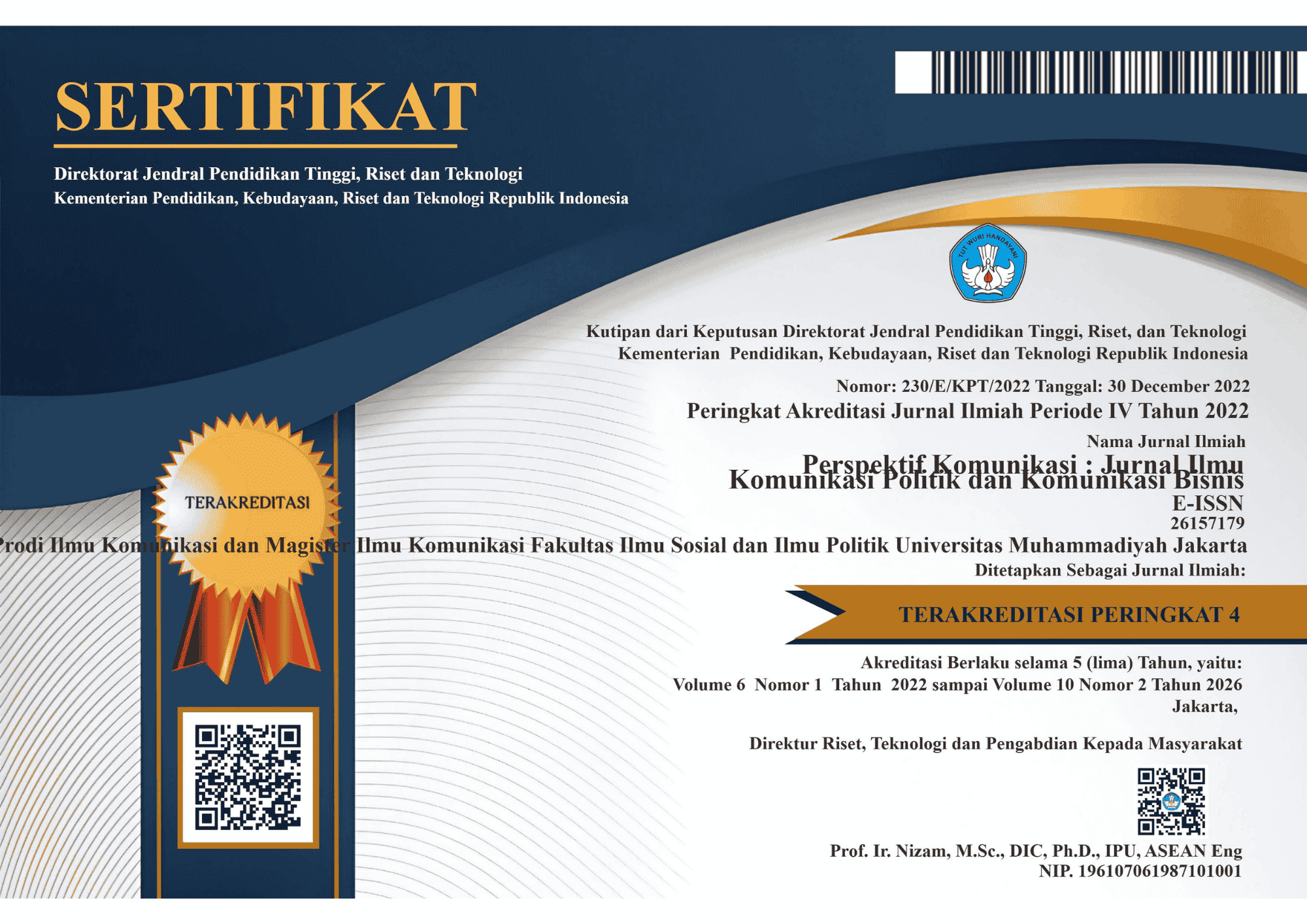WAZUP! COMMUNICATION TOOLS IN ORGANIZATIONAL DECISION-MAKING
DOI:
https://doi.org/10.24853/pk.7.1.103-114Keywords:
WhatsApp, Internal Communication, Decision-making, Organizational CommunicationAbstract
The WhatsApp application has become the latest trend as a communication tool used in organizations to interact with each other. Most of its use is to convey official or personal information and get immediate feedback. Employees can send information and attach text, images, videos, and audio files. Additionally, users can form specific groups through the WhatsApp application. However, it is unclear to what extent WhatsApp is used as a communication tool that supports decision-making in organizations. This study aims to identify the extent to which WhatsApp is used in the organization and employees' perspectives as an internal organizational communication tool supporting employee decision-making. A quantitative survey method was used to distribute this study through email to executives and non-executives from the selected organization, namely the Malaysian Communications and Multimedia Commission (SKMM), a regulatory body organization under the Ministry of Communications and Digital. Based on the findings of the study, WhatsApp is widely used by SKMM staff to share information, manage daily work routines, and make quick and effective decisions. This WhatsApp is considered an alternative that can be used as a communication tool that supports quick decision-making by the staff in the organization. Most of them agree and gain satisfaction from its use, especially when an immediate decision is needed. The study also shows that all MCMC employees need WhatsApp communication during working hours.References
Allagui, B. (2014). Writing through WhatsApp: An Evaluation of Students Writing Performance. International Journal of Mobile Learning and Organisation, 8(3/4) 216 -231)
Ariffin, Z., & Omar, S. Z. (2018). Usage of WhatsApp in Relation to Employee Engagement in a Telecommunication Company. International Journal of Academic Research in and Social Sciences, 8(1), 434–452.
Barhoumi, C. (2015). The Effectiveness of WhatsApp Mobile Learning Activities Guided by Activity Theory on Students' Knowledge Management. Journal of Contemporary Educational Technology, 6(3), 221-238.
Bouhnik, D., & Deshen, M. (2014). WhatsApp goes to school: Mobile instant messaging between teachers and students. Journal of Information Technology Education: Research, 13, 217-231.
Chairunnisa, S., & Benedictus, A. S. (2017). Analysis of Emoji and Emoticon Usage In Interpersonal Communication Of Blackberry Messenger And WhatsApp Application User. International Journal of Sosial Sciences and Management, 4(2), 120-126.
Davis, F. D. (1989). Perceive usefulness, perceived ease of use and user acceptance of information technology. MIS Quarterly, 13(3), 319-340
Deepthi, Patil, S., & Tadasad, P. (2015). Usage of WhatsApp messenger amongst post graduate students in a university environment: A study of Karnataka state women's university, Vijayapura. International Journal of Multidisciplinary Research and Development, 2(11), 591-594.
Drago, E. (2015). The effect of technology on face-to-face Communication. Elon Journal of Undergraduate Research in Communications, 6(1), 1-7.
Hamilton, C. (2008). Communicating For Results: A Guide For Business And The Professions (8th ed.). Belmont: Thomson Wadsworth.
Hashim, N., Shahid, N. M., & Razak, M. N. F. (2022). Relationship between Whatsapp Usage and Employee Engagement in Ministry of Communication and Multimedia Malaysia. International Journal of Academic Research in Business and Social Sciences, 12(4), 1234–1262.
Kariuki Naomi Faith Wariara. (2017) Use of Whatsapp as An Organizational Communication Platform: A Case of Kenya's Safaricom Technology Division. United States International University – Africa. A Thesis Submitted to the School of Science and Technology in Partial Fulfillment of the Requirements of the Degree of Master of Arts in Communication. United States International University – Africa.
Katz, E. (1959). Mass Communications Research And The Study Of Popular Culture: An Editorial Note On A Possible Future for this Journal. Studies in Public Communication, 2, 1-6.
Katz, Elihu, Blumler, Jay G., Gurevitch, Michael. (1973). Uses And Gratifications Research. Public Opinion Quarterly, 37 (4), 509-523.
Katz, E., Blumler, J.G. and Gurevitch, M. (1974), Utilization of mass communication by the individual. In Blumler, J.G. and Katz, E. (Eds), The Uses Of Mass Communications: Current Perspectives On Gratifications Research, Sage, Beverly Hills, pp. 19-32.
Lee Chin Yin. (2016). Adoption of WhatsApp Instant Messaging Among Students in Ipoh Higher Education Institution School of Education, Language, Communication Wawasan Open University. Project Report submitted in partial fulfillment of the requirements for the award of Master of Education. Wawasan Open University Penang, Malaysia.
Malaysian Communications and Multimedia Commission (MCMC). (2020). Internet user survey 2020. https://www.mcmc.gov.my/skmmgovmy/media/General/pdf/IUS-2020-Report.pdf
Mariana, E., & Putri, N. (2017, March). Communication in Educational Institution: Can We Implement Paperless Communication? (A Study at Tanri Abeng University). In Proceedings Ngai, E. W., Moon, K. L.
K., Lam, S. S., Chin, E. S., & Tao, S. S. (2015). Social media models, technologies, and applications: an academic review and case study. Industrial Management & Data Systems, 115(5), 769-802.
Montag, C., Błaszkiewicz, K., Sariyska, R., Lachmann, B., Andone, I., Trendafilov, B., Markowetz, A. (2015). Smartphone usage in the 21st century: who is active on WhatsApp? BMC Research Notes, 8(1), 331.
Müller, J. (2021, August 17). Smartphone users in Malaysia 2017-2023. [Available Online ]. Statista. https://www.statista.com/statistics/494587/smartphone-users-in-malaysia/. Accessed at November 01 2022.
Noa Aharony, Taly Gazit. (2016). The Importance of the WhatsApp Family Group: An Exploratory Analysis, Aslib Journal of Information Management, 68 (2),174-192, https://Doi.Org/10.1108/Ajim-09-2015-0142.
Ruggiero, T. E. (2000). Uses and gratifications theory in the 21st Century. Mass Communication & Society, 3(1), 3-37.
Suriana Johari, Wan Norbani Wan Noordin Tengku Elena Tengku Mahamad. (2022). Universiti Teknologi MARA, WhatsApp Conversations and Relationships: A Focus on Digital Communication Between Parent-Teacher Engagement in a Secondary School in Putrajaya. Malaysian Journal of Communication ; 38(2), 280-296.
West, R. L., Turner, L. H., & Zhao, G. (2010). Introduction of Communication Theory: Analysis and Application. New York, NY: McGraw-Hill.
WhatsApp. (n.d.). WhatsApp. Retrieved October 01, 2016, from WhatsApp: http://blog.whatsapp.com/.
Yeboah, J., & Ewur, G. D. (2014). The impact of Whatsapp messenger usage on students performance in tertiary institutions in Ghana. Journal of Education and Practice,5(6),157–164. [Available Online] http://www.iiste.org/Journals/index.php/JEP/article/view/11241/11555. Accessed at 30 December 2022.


_2.png)


1.png)

2.png)



















